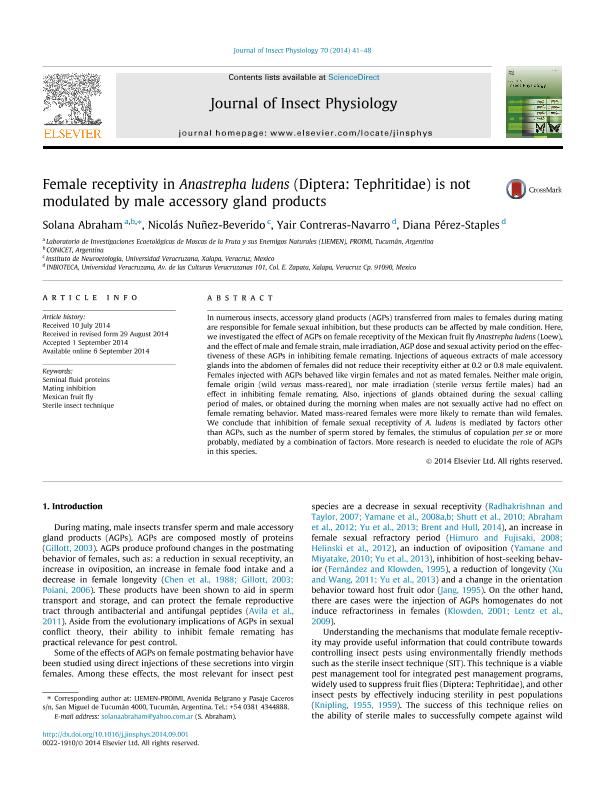Mostrar el registro sencillo del ítem
dc.contributor.author
Abraham, Solana

dc.contributor.author
Nuñez Beverido, Nicolas
dc.contributor.author
Contreras Navarro, Yair
dc.contributor.author
Pérez Staples, Diana
dc.date.available
2017-02-07T18:40:36Z
dc.date.issued
2014-11
dc.identifier.citation
Abraham, Solana; Nuñez Beverido, Nicolas; Contreras Navarro, Yair; Pérez Staples, Diana; Female receptivity in Anastrepha ludens (Diptera: Tephritidae) is not modulated by male accessory gland products; Elsevier; Journal Of Insect Physiology; 70; 11-2014; 41-48
dc.identifier.issn
0022-1910
dc.identifier.uri
http://hdl.handle.net/11336/12669
dc.description.abstract
In numerous insects, accessory gland products (AGPs) transferred from males to females during mating are responsible for female sexual inhibition, but these products can be affected by male condition. Here, we investigated the effect of AGPs on female receptivity of the Mexican fruit fly Anastrepha ludens (Loew), and the effect of male and female strain, male irradiation, AGP dose and sexual activity period on the effectiveness of these AGPs in inhibiting female remating. Injections of aqueous extracts of male accessory glands into the abdomen of females did not reduce their receptivity either at 0.2 or 0.8 male equivalent. Females injected with AGPs behaved like virgin females and not as mated females. Neither male origin, female origin (wild versus mass-reared), nor male irradiation (sterile versus fertile males) had an effect in inhibiting female remating. Also, injections of glands obtained during the sexual calling period of males, or obtained during the morning when males are not sexually active had no effect on female remating behavior. Mated mass-reared females were more likely to remate than wild females. We conclude that inhibition of female sexual receptivity of A. ludens is mediated by factors other than AGPs, such as the number of sperm stored by females, the stimulus of copulation per se or more probably, mediated by a combination of factors. More research is needed to elucidate the role of AGPs in this species.
dc.format
application/pdf
dc.language.iso
eng
dc.publisher
Elsevier

dc.rights
info:eu-repo/semantics/openAccess
dc.rights.uri
https://creativecommons.org/licenses/by-nc-nd/2.5/ar/
dc.subject
Seminal Fluid Proteins
dc.subject
Mating Inhibition
dc.subject
Mexican Fruit Fly
dc.subject
Sterile Insect Technique
dc.subject.classification
Zoología, Ornitología, Entomología, Etología

dc.subject.classification
Ciencias Biológicas

dc.subject.classification
CIENCIAS NATURALES Y EXACTAS

dc.title
Female receptivity in Anastrepha ludens (Diptera: Tephritidae) is not modulated by male accessory gland products
dc.type
info:eu-repo/semantics/article
dc.type
info:ar-repo/semantics/artículo
dc.type
info:eu-repo/semantics/publishedVersion
dc.date.updated
2017-02-07T17:51:43Z
dc.journal.volume
70
dc.journal.pagination
41-48
dc.journal.pais
Países Bajos

dc.journal.ciudad
Amsterdam
dc.description.fil
Fil: Abraham, Solana. Consejo Nacional de Investigaciones Científicas y Técnicas. Centro Científico Tecnológico Tucumán. Planta Piloto de Procesos Industriales Microbiológicos (i); Argentina
dc.description.fil
Fil: Nuñez Beverido, Nicolas. Universidad Veracruzana; México
dc.description.fil
Fil: Contreras Navarro, Yair. Universidad Veracruzana. Instituto de Biotecnologia y Ecologia Aplicada; México
dc.description.fil
Fil: Pérez Staples, Diana. Universidad Veracruzana. Instituto de Biotecnologia y Ecologia Aplicada; México
dc.journal.title
Journal Of Insect Physiology

dc.relation.alternativeid
info:eu-repo/semantics/altIdentifier/doi/http://dx.doi.org/10.1016/j.jinsphys.2014.09.001
dc.relation.alternativeid
info:eu-repo/semantics/altIdentifier/url/http://www.sciencedirect.com/science/article/pii/S0022191014001656
Archivos asociados
